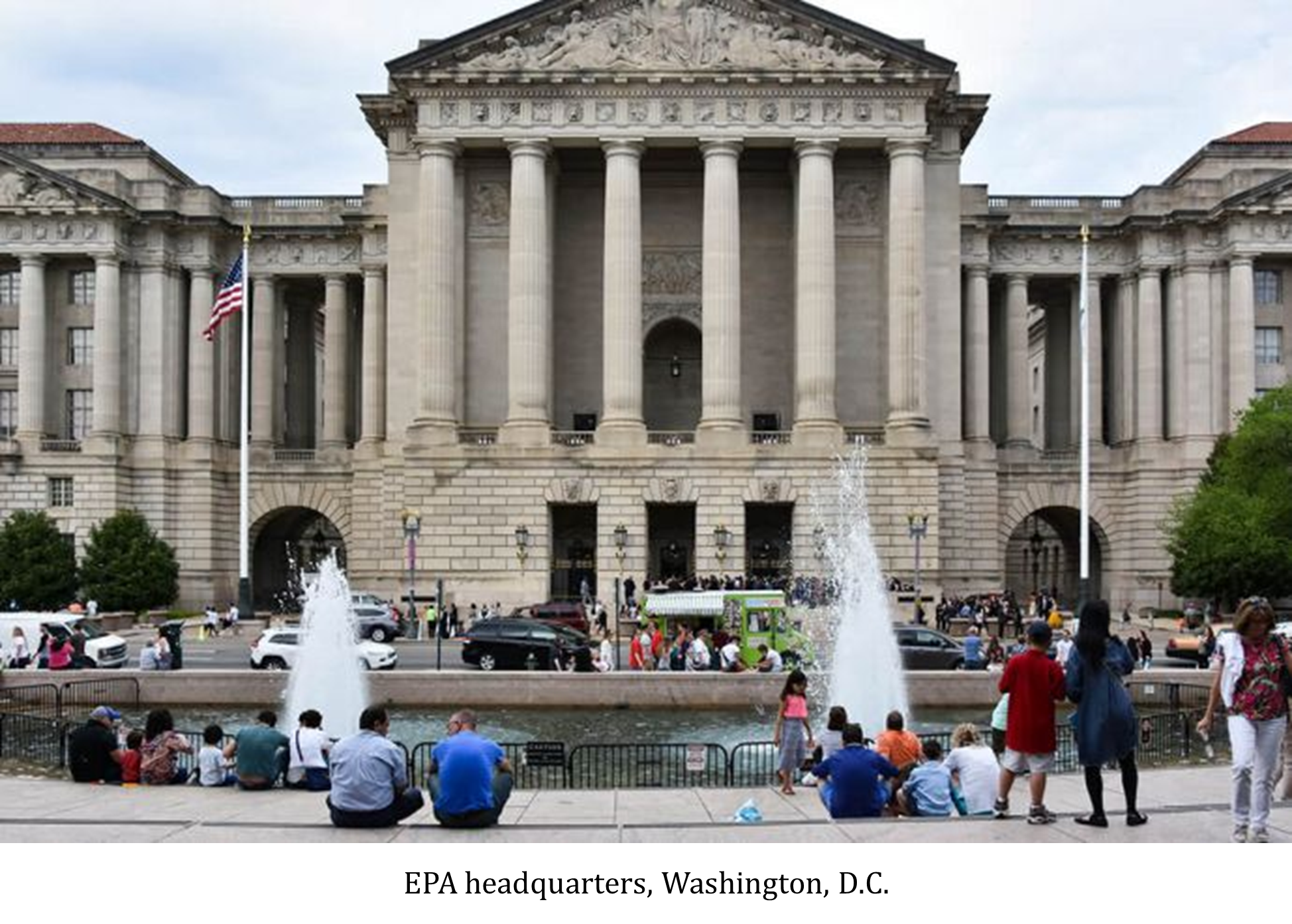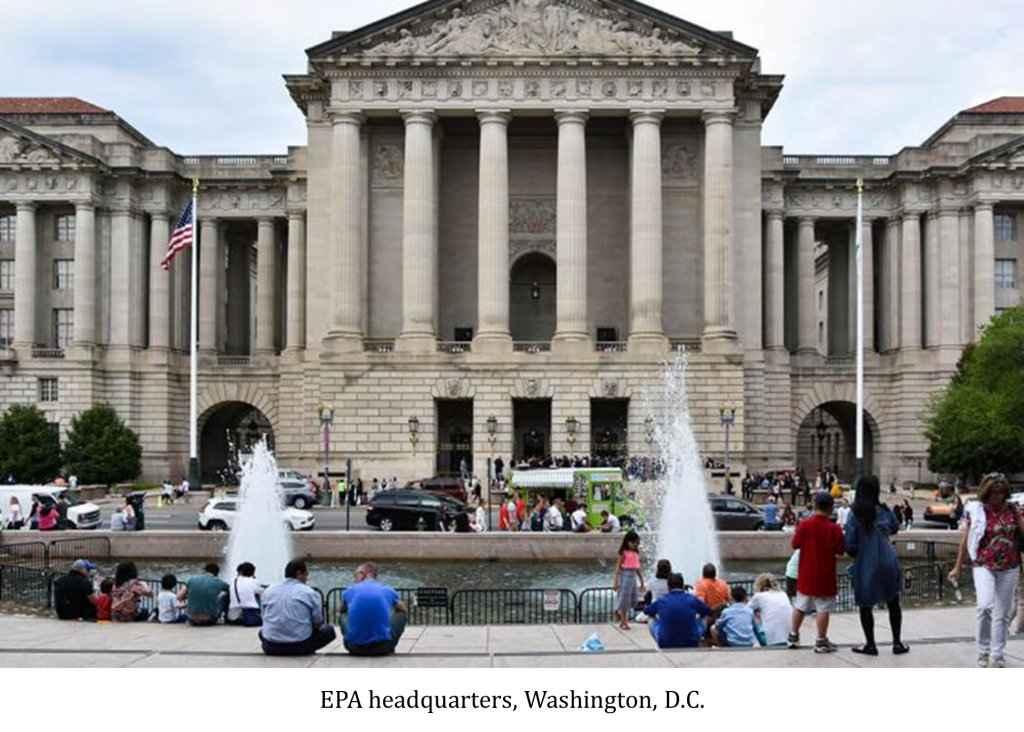1/5/2021 By Michael Garry
EPA(米国環境保護局)は、米国がまだ批准していないモントリオール議定書キガリ改正に沿ってHFCの生産と消費を2036年までに85%削減する割当量プログラムの規定を委任される。

産業界と環境保護関係団体が合同で支持し長く待ち望まれた動きとして、米国政府は、モントリオール議定書キガリ改正に沿った15年にわたるHFCの段階的削減を承認する超党派議員グループによる法案を成立させた。
2019年10月に上院に提出されたS.2754 -American Innovation and Manufacturing Act of 2019※1を受けて下院で2020年1月に提出された H.R.5544 -American Innovation and Manufacturing Act of 2020※2(AIM法)は、EPAに対してHFCの生産及び消費を2036年までに2011年から2013年の年平均を基準としてその約15%に削減することを義務付けるものである。
AIM法は、1.4兆ドルの政府支出法案と9,000億ドルの新型コロナウイルス感染救済法案を含む、2021年連結歳出法(H.R.133-Consolidated Appropriations Act, 2021※3)という超党派の大規模な法案パッケージの一部である。トランプ前大統領は2020年12月27日同法に署名した。
AIM法は、以下のことを実施する。
- 割当量プログラムを用いてHFCの生産と消費を段階的に削減する。
- 回収、再生、及び付帯サービス、修理、廃棄手順の改善を通じて冷媒用途HFCの管理基準の策定をEPAに委任する。これにより、2020年に施行されたEPA規制を覆すことができると思われる。このEPA規制は、ほとんどのスーパーマーケット用機器や産業用機器など50ポンド(23 kg)以上の冷媒が封入された機器の冷媒漏れ修理要件をHFC及びHFOに拡大する規則を取り消したものである。
- 小規模企業向けの 3 年間の助成金プログラムを創設し、使用済み冷媒の回収及び再生を促進するために毎年 500 万ドルを計上する。
- 次世代技術への移行を促進するために、分野別の使用制限を設けることをEPAに認可する。
AIM法は段階的削減の対象となる純HFCのリストを含むが、これはキガリ改正で使用されたものとほぼ同じ内容である。R404Aのような純HFCの混合物から成るHFCに関しては、「割当量はHFCの成分に対してのものになる。したがってR404Aを生産あるいは輸入する場合、R125、R143a、R134aに対応する割当量が必要である。」と環境調査庁(EIA)の上級政策アナリストであるクリスティーナ・スター氏は述べた。
参考:
※1:https://www.congress.gov/bill/116th-congress/senate-bill/2754/text
※2:https://www.congress.gov/bill/116th-congress/house-bill/5544/text
※3:https://www.congress.gov/bill/116th-congress/house-bill/133/text
【 下記記事の抄訳 】
U.S. Enacts HFC Phase-Down Law as Part of COVID Relief Bill
1/5/2021 By Michael Garry
EPA is charged with establishing allowance program to cut HFC production/consumption by 85% by 2036, in line with yet-to-be-ratified Kigali Amendment.

In a long-awaited move supported by a coalition of business and environmental stakeholders, the U.S. government has enacted bipartisan legislation authorizing a 15-year phase down of HFCs in alignment with the Kigali Amendment to the Montreal Protocol.
Originally introduced in January 2020 by the U.S. House of Representatives following a similar bill in the Senate, the American Innovation and Manufacturing Act of 2020 (AIM) requires the Environmental Protection Agency (EPA) to implement a phase down of the production and consumption of HFCs in order to reach approximately 15% of their 2011-2013 average annual levels by 2036.
AIM is part of a sweeping bipartisan legislative package, the Consolidated Appropriation Act, 2021, which includes a $1.4 trillion government spending bill and $900 billion COVID-19 relief package bill. President Trump, who will be replaced by President-Elect Joe Biden on January 20, signed the Act on December 27.
AIM will:
- Phase down the production and consumption of HFCs through an allowance program.
- Authorize the EPA to establish standards for the management of HFCs used as refrigerants through recovery, reclamation and improved servicing, repair, and disposal practices. This could reverse an EPA rule enacted in 2020 that rescinded a rule extending refrigerant leak repair requirements to HFCs and HFOs for equipment containing more than 50lbs (23kg) of refrigerant, including most supermarket and industrial applications.
- Create a three-year grant program for small businesses, allocating $5 million annually toward increasing recovery and reclamation of refrigerants at end of life.
- Authorize the EPA to establish sector-based use restrictions, facilitating the transition to next-generation technologies.
The AIM law includes a list of pure HFCs targeted for phase down that is largely the same as that used in the Kigali Amendment. For HFCs like R404A, which consists of a blend of pure HFCs, “the allowances will be for the HFC components,” said Christina Starr, Senior Policy Analyst for the Environmental Investigation Agency (EIA). “So if you were producing or importing R404A, you’d need allowances for corresponding amounts of R125, R143A, and R134a.”
For HFC-HFO blends, only the HFC portion would be subject to allowance limits, she added.
Return to federal action
By implementing these measures, the EPA will resume its regulation of HFCs, which had been sidelined by the U.S. Court of Appeals ruling in 2017, and then by the EPA’s decision to expand upon that ruling.
In the absence of federal action, a number of states, led by California, have adopted the SNAP rules on HFCs, among other measures. California’s Air Resources Board last month approved new regulations that expand the state’s refrigerant restrictions considerably, including a 150-GWP cap on refrigerants used in new commercial and industrial equipment, beginning in 2022.
AIM would provide a more standard approach to HFC regulation across all states, though it would not prevent California from following through on its stricter provisions as they apply to refrigeration and air conditioning, noted Starr. Federal allocation rules would take over for niche applications deemed an “essential use” for which there are no alternatives, she added.
In general, the AIM law “paves the way for the Biden Administration to increase the ambition and effectiveness of our domestic federal policy framework to reduce HFCs,” said Starr in a statement. “It doesn’t go as far as we’d ultimately like in requiring complete elimination of these gases, but the broader authority it gives EPA to better manage and restrict HFCs throughout their lifecycle provides more tools to increase emission reductions to meet net-zero emission targets.”
While AIM aligns the U.S. with the 85% phase down of HFCs required under the Kigali Amendment for developed countries by 2036, the Trump administration has not sent the Amendment to the U.S. Senate for ratification. However, Biden has said that he intends to “embrace” the Kigali Amendment in his first 100 days. He also intends to support “refrigeration and air conditioning using refrigerants with no global warming potential.” (Ammonia (R717) is the only refrigerant with zero GWP; he may have meant zero or “near-zero” GWP refrigerants like CO2 (R744) and propane (R290)).
Avipsa Mahapatra, Climate Campaign Lead for EIA, described the AIM law as “the most significant climate legislation to pass in the U.S. congress in over a decade.” Moreover, she said, “It sends a signal that one of the largest contributors to climate change, the United States, is back at the global climate action table, after four years of appalling inaction.”
The AIM law “paves the way for the Biden Administration to increase the ambition and effectiveness of our domestic federal policy framework to reduce HFCs.”
– Christina Starr, EIA
Source: U.S. Enacts HFC Phase-Down Law as Part of COVID Relief Bill (ammonia21.com)